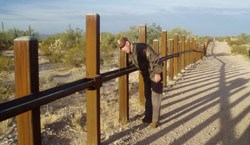
For the longest time, the only indication of an international border was stone obelisks placed every few miles across the border. Eventually a barbed-wire fence appeared to keep livestock and vehicles from entering the desert wilderness of Organ Pipe Cactus. In the mid-1900s, the land surrounding Organ Pipe Cactus became prime corridors for illegal trade due to its rugged terrain, yet close proximity to major metropolitian areas. To avoid detection, many individuals began illegally driving through the barbed-wire fence. The damage caused by this illegal use was astounding. Eventually more than 200 miles of illegal roads traversed Organ Pipe Cactus. In 2004, the monument undertook the work of constructing a vehicle barrier along the south boundary at the Mexico border. It stretches 30 miles of our southern boundary. The barrier was designed to stop vehicles from driving around the US customs offices in Lukeville on Highway 85, or up through the desert wilderness instead of using Highway 85. In 2006, the NPS finished building thesteel fence. Although the three-year construction project was costly, the natural and cultural resources it has protected are priceless. It also provides positive value to visitor safety, officer safety, and our national security. 
Sue Rutman, NPS Photo The vehicle barrier has stopped nearly all off-road vehicle traffic through Organ Pipe Cactus National Monument. The barrier has not been breached, and monitoring has revealed a dramatic decline in illegal off-road vehicle activity. Visitor safety has increased, as the potential for high-speed chases along park roads has virturally vanished. The barrier design allows water, and animals, including the highly endangered Sonoran Pronghorn, to safely roam their natural ranges uninterrupted. In 2015, the National Park Service, in partnership with the Department of Homeland Security and neighboring public lands, embarked on a sucessful Wilderness Restoration project to restore the disturbed lands to their natural state. |
Last updated: July 29, 2023
